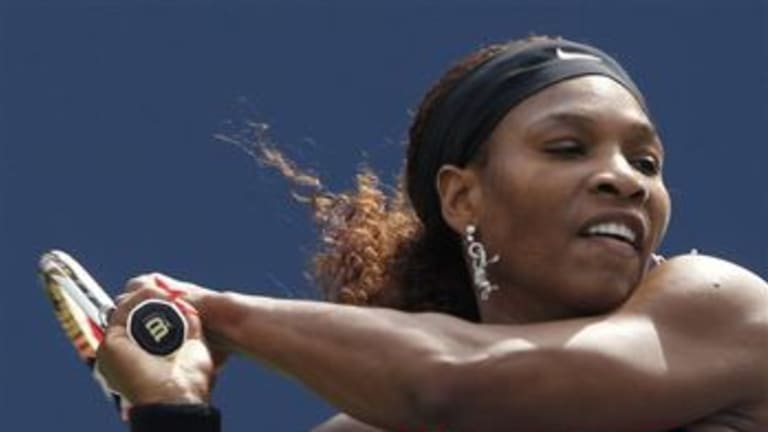NEW YORK—It had been a while since I’d last seen Serena Williams play live. I caught a few games of her loss to Marion Bartoli at Wimbledon, but nothing else since last summer. It’s always a little bit of a shock to see a living legend right in front of you. You might think it would diminish them in some way, or at least make you realize that they’re human like you. But with Serena, I always think: “Now I get it.” While a lot of her obviously translates on TV, some of the subtleties of what makes her great are lost.
She’s not unique in this regard, of course. The man who preceded her onto Ashe today, Roger Federer, who is her age and also qualifies as a living legend, is noticeably different in person. The competitive edges below the serene surface are visible. With Serena, it’s something like the opposite. The fundamentals of what’s made her so good for so long can seem mysterious from afar. How does she hit so many off-balance shots so precisely? How is she still as fast as she is, when she says she trains by “praying”? You get a better idea in person.
To start, there’s her physical presence. I don’t mean her size or her frame, but the way she walks and carries herself. She moves slowly and deliberately, but it’s the slow, deliberate walk of authority, of the cop on the beat. And while she’s only stretching her shoulder when takes those warm-up serve swings during the coin toss, it still looks intimidating—she’s whipping her racquet right at her opponent over and over. As that opponent today, Victoria Azarenka, said, “She doesn’t give you any space.” That starts when Serena walks on the court. After 17 minutes of this match, she was up 5-0.
We think of power above all when we think of Serena, but from the start today, it wasn’t raw power that was winning her points, it was placement. It used to be said that nobody could consistently open up the court the way Federer could. Nobody could stand in the middle of the baseline and create the angles he created; most players need an angle—say, one corner to another—to create one. Serena also has that Federer-esque ability from the center of the court. She elevated herself above her sister in 2003 by, as she said, “using those angles” and moving Venus into the alleys with them. And she’s still doing it eight years later. At its simplest, this match was decided by Serena’s ability to hit closer to the sidelines, earlier in the points, with more confidence and consistency than Azarenka. Often it started on the second shot of the point, with her return. By the middle of the second set, Azarenka had won just 33 percent of points on her second serve. She was always playing catch-up in the rallies.
Serena walks slowly, and often breathes heavily between points, which makes her ability to get to so many balls surprising. She doesn’t look faster in person, but you notice that she moves economically. There’s not much wasted motion, she cuts off the angles well, she uses her open stance to help her recover quickly, and she does that most fundamental of fundamentals, she stays on her toes. This extreme dedication to the basics extends to every part of Serena’s game. Many if not most champions use an unorthodox style; they bring a touch of individual genius to the game, a genius that can turn into a new orthodoxy. And Serena does, too. She and her sister pioneered the open-stance backhand. But for the most part she adheres to the textbook. The racquet is back early, the service motion is uncluttered, the strokes are simple but durable. She makes the textbook look like genius.
Azarenka said that the first set was the best tennis she’s seen from Serena since she, Azarenka, joined the tour. This was worthy of a Grand Slam semifinal, and you might even say that the fact that Azarenka could make a match of it was a step forward for her. She never caved or got discouraged. Instead, she changed the dynamics of the rallies by moving forward and taking the ball earlier. But in the end Serena had one more textbook move up her sleeve. Despite being broken when she served for the match, she put it behind her right away and won the tiebreaker anyway.
The first big matchup of the tournament is over, and living legend marches on, seemingly with her powers undiminished after 13 years on tour. She took the most consistent of the WTA’s young stars and completely overwhelmed her for half an hour. Up close, you see why no one can match her. I saw it best today when she was hitting her backhand on my side of the court, when I was a few feet away. You may know she hits the ball hard from seeing her on TV, but in person you get to feel her whip her racquet around her head on her backhand. It’s a two-handed left hook, and its speed almost knocks you back in the stands. It’s worse if you’re on the other side of the net; it was her backhand that won her the tiebreaker. When Azarenka was asked what it was like to face Serena at her best, she summed it up with one word: “painful.”
We keep waiting for Serena’s successor to arrive. There are many things a young player could and should copy about her game, but then you would also have to match that whip. I haven’t felt anything quite like it here yet.
